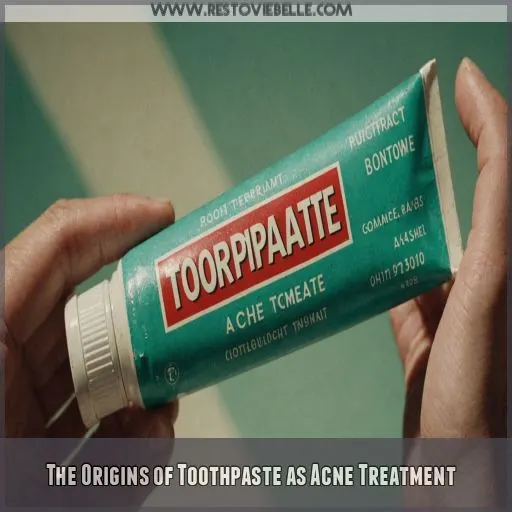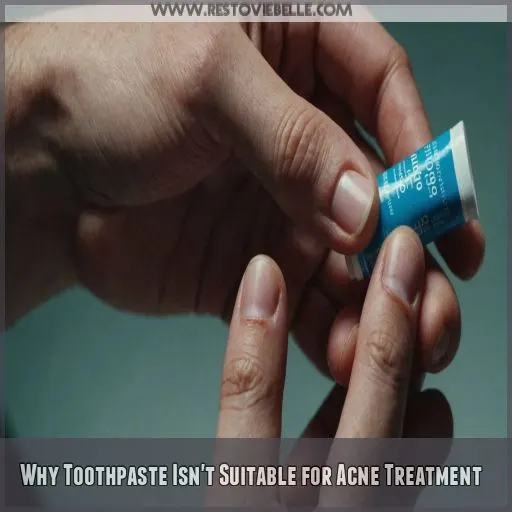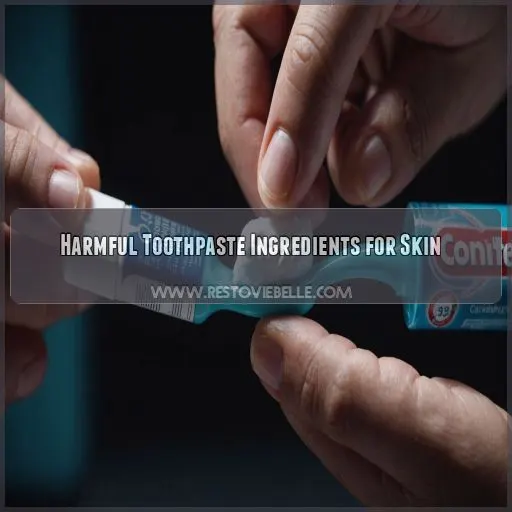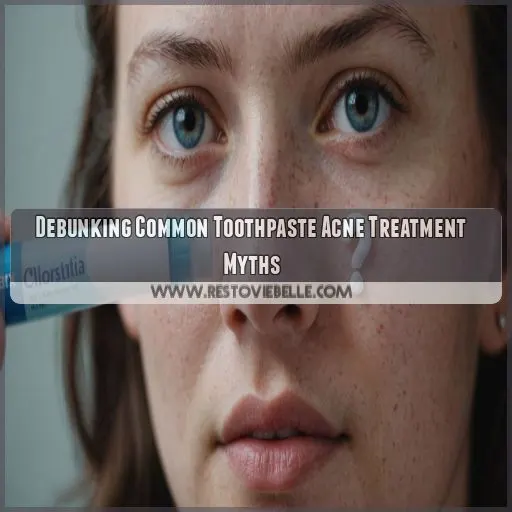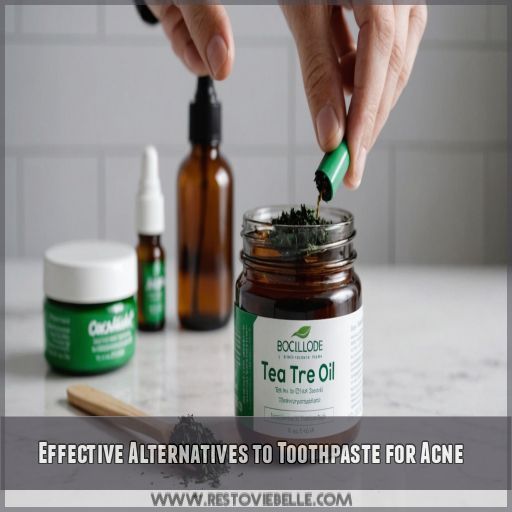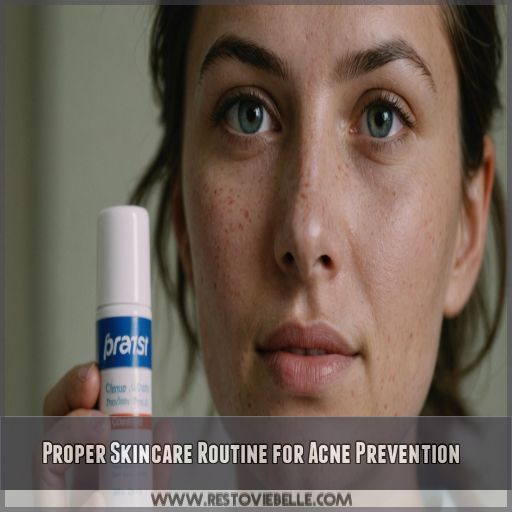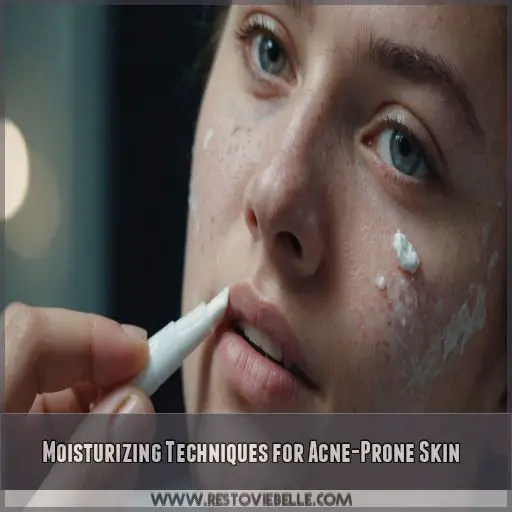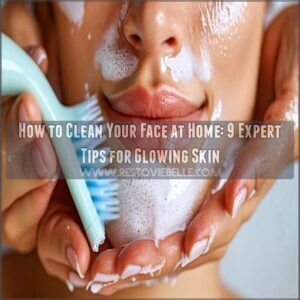This site is supported by our readers. We may earn a commission, at no cost to you, if you purchase through links.
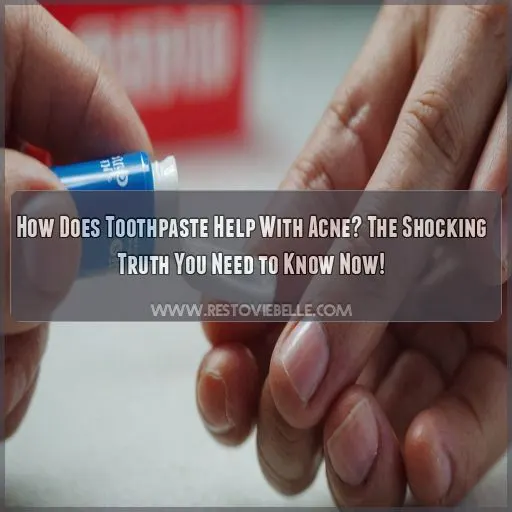 Contrary to popular belief, toothpaste doesn’t actually help with acne.
Contrary to popular belief, toothpaste doesn’t actually help with acne.
In fact, it can make things worse!
The old myth about how toothpaste helps with acne stemmed from an ingredient called triclosan, which used to be in toothpaste.
But here’s the kicker: the FDA banned triclosan in 2017 due to health concerns.
Today’s toothpaste contains ingredients that are great for your teeth but not so great for your skin.
Think of it like using a hammer to fix a leaky faucet – wrong tool for the job!
Using toothpaste on pimples can irritate your skin, disrupt its natural balance, and even lead to more breakouts.
Ready to discover what really works for acne?
Table Of Contents
- Key Takeaways
- The Origins of Toothpaste as Acne Treatment
- Why Toothpaste Isn’t Suitable for Acne Treatment
- Harmful Toothpaste Ingredients for Skin
- Debunking Common Toothpaste Acne Treatment Myths
- Effective Alternatives to Toothpaste for Acne
- Proper Skincare Routine for Acne Prevention
- Moisturizing Techniques for Acne-Prone Skin
- Frequently Asked Questions (FAQs)
- Is toothpaste good for acne?
- How to clear a pimple overnight?
- What dries out pimples?
- How does Colgate help on the face?
- How long should toothpaste be left on a pimple?
- Can whitening toothpaste help with acne scars?
- Are natural toothpastes safer for treating acne?
- Does the flavor of toothpaste affect its acne-fighting ability?
- Can toothpaste be combined with other acne treatments?
- Conclusion
Key Takeaways
- You’ve been duped! Toothpaste doesn’t actually help with acne – it can make things worse by irritating your skin and disrupting its natural balance. Time to put that tube back where it belongs: in your bathroom, not on your face!
- The old myth about toothpaste zapping zits stemmed from an ingredient called triclosan, but here’s the kicker: the FDA banned it in 2017 due to health concerns. Your current toothpaste is great for your pearly whites, but it’s like using a sledgehammer to hang a picture – wrong tool for the job!
- Ditch the DIY disaster and opt for acne-specific treatments instead. Look for products with salicylic acid or benzoyl peroxide – they’re your skin’s new best friends in the battle against breakouts.
- Remember, a proper skincare routine is your secret weapon against acne. Cleanse gently, moisturize (yes, even if you’re oily!), and protect your skin from the sun. Your face will thank you for not subjecting it to minty torture!
The Origins of Toothpaste as Acne Treatment
You might be surprised to learn that toothpaste was once hailed as a miracle acne cure. The secret behind this odd beauty hack? It all started with an ingredient called triclosan, which was believed to zap those pesky pimples overnight.
Historical Use of Triclosan in Toothpaste
You’ve probably heard that toothpaste zaps zits, right? Well, it used to contain triclosan, an antibacterial ingredient. Folks thought it’d kill acne-causing bacteria. But here’s the kicker: the FDA banned triclosan in 2017 due to health concerns.
Outdated Reasoning Behind Toothpaste Spot Treatments
You’ve heard the old wives’ tale: toothpaste zaps zits overnight. But here’s the kicker – it’s outdated! Let’s bust some acne myths:
- Triclosan’s gone from US toothpastes
- Harsh ingredients irritate skin
- Better alternatives exist
FDA Regulations on Triclosan Usage
You might be surprised to learn that the FDA cracked down on triclosan in 2017. Here’s a quick rundown of what happened:
| Year | FDA Action |
|---|---|
| 2016 | Raised concerns |
| 2017 | Banned in soaps |
| 2019 | Limited in hand sanitizers |
| 2020 | Phased out in toothpaste |
This shakeup left many wondering: what’s next for our acne-fighting arsenal?
Current Status of Triclosan in US Toothpastes
You might be surprised to learn that triclosan, once a common ingredient in toothpaste, is now off the menu in the US. The FDA put the kibosh on it back in 2017, citing health concerns.
Why Toothpaste Isn’t Suitable for Acne Treatment
You might’ve heard that toothpaste can zap zits overnight, but here’s the shocking truth: it’s doing your skin more harm than good. Let’s uncover why that tube of minty freshness belongs nowhere near your face and what you should use instead to battle those pesky pimples.
Toothpaste Formulation for Dental Health
You’ve been brushing with a dental powerhouse! Toothpaste is packed with ingredients like fluoride, whitening agents, and tartar control formulas. It’s a champion for your pearly whites, but your skin? Not so much. Let’s explore why.
Harsh Ingredients in Toothpaste
While toothpaste works wonders for your pearly whites, it’s not your skin’s best friend. Those ingredients that keep your teeth sparkling can wreak havoc on your face. Here’s why:
- Fluoride: Great for teeth, not so much for skin
- Sodium lauryl sulfate: A foaming agent that can clog pores
- Abrasives: Too harsh for delicate facial skin
- Alcohol: Drying and irritating
- Artificial colors and fragrances: Potential allergens
Potential Skin Irritation and Inflammation
Ever slathered toothpaste on a zit? Yikes! It’s like throwing gasoline on a fire. Those harsh ingredients can turn your skin into an angry, red battlefield. Trust us, your face deserves better than minty-fresh torture!
Negative Effects on Pimples and Overall Skin Health
- Triggers more breakouts
- Disrupts your skin’s natural barrier
- Causes long-term damage
Harmful Toothpaste Ingredients for Skin
You might be surprised to learn that your favorite toothpaste contains ingredients that can wreak havoc on your skin. Let’s uncover the hidden culprits in toothpaste that make it a terrible choice for treating acne, and why you should keep it far away from your face.
Tartar-reducing Components
You might think tartar-reducing ingredients in toothpaste are great for your teeth, but they’re not so friendly to your skin. These powerful components can wreak havoc on your face, causing irritation that’ll make your acne woes even worse.
Enamel-strengthening Ingredients
You’ve heard about tartar-reducing ingredients, but what about enamel-strengtheners? They’re great for your pearly whites, but not so much for your skin. Here’s why these toothpaste heroes can be acne villains:
- Fluoride: Protects teeth, irritates skin
- Calcium phosphate: Hardens enamel, clogs pores
- Hydroxyapatite: Repairs tooth structure, disrupts skin barrier
- Stannous fluoride: Fights decay, causes redness
Abrasive Substances in Toothpaste
Now, let’s talk about the gritty truth: abrasives in toothpaste. These tiny particles are great for polishing teeth, but they’re like sandpaper on your skin. Check out this breakdown of common abrasives:
| Abrasive | Effect on Teeth | Effect on Skin |
|---|---|---|
| Baking Soda | Gentle whitening | Drying, irritating |
| Silica | Removes plaque | Micro-tears |
| Calcium Carbonate | Polishes enamel | Rough, inflaming |
| Alumina | Stain removal | Harsh exfoliation |
| Whitening Agents | Brightens smile | Potential burns |
Yikes! These micro-abrasives might make your pearly whites shine, but they’re no friend to your face.
Fragrances and Artificial Colors
Ever wonder why your skin gets irritated after using toothpaste on pimples? The culprits might be hiding in plain sight. Fragrances and artificial colors in toothpaste can trigger skin allergies and sensitivity, making your acne worse instead of better.
Debunking Common Toothpaste Acne Treatment Myths
You’ve probably heard that toothpaste can zap zits overnight, but is this DIY remedy too good to be true? Let’s bust some common myths about using toothpaste for acne and uncover why it might do more harm than good for your skin.
Drying Effect on Pimples
You might think toothpaste’s drying effect is a pimple’s worst nightmare, but hold your horses! It’s actually overkill for your skin. Excessive drying can backfire, triggering more oil production and potentially worsening your acne woes.
Antibacterial Properties for Acne
You might’ve heard toothpaste kills acne bacteria, but that’s a myth. Here’s what really happens:
- Your skin barrier gets disrupted
- Beneficial bacteria are wiped out
- Acne-causing bacteria thrive in the chaos
Don’t fall for this old wives’ tale!
Quick Fix for Overnight Results
You’ve heard the rumors: toothpaste zaps zits overnight! Sorry to burst your bubble, but it’s not the miracle cure you’ve been hoping for. Quick fixes are tempting, but they often do more harm than good.
Safety of Natural Toothpaste Ingredients
You might think natural toothpastes are safer for acne, but hold your horses! Even herbal extracts and essential oils can irritate your skin. Fluoride and whitening agents? They’re not your skin’s best friends either. Stick to skincare products instead!
Effective Alternatives to Toothpaste for Acne
You might be surprised to learn that toothpaste isn’t actually a miracle cure for acne. Instead, let’s explore some effective alternatives that are specifically designed to tackle those pesky pimples without risking irritation or damage to your skin.
Over-the-counter Spot Treatments
Now that we’ve busted those toothpaste myths, let’s talk about real solutions. Over-the-counter spot treatments are your acne-fighting superheroes. They’re designed specifically for your skin, unlike that tube of Colgate. Here’s what makes them awesome:
- Targeted ingredients that zap zits
- Gentler on your skin than harsh toothpaste
- Come in various forms (gels, patches, creams)
- Often work overnight
- Readily available at your local drugstore
Benzoyl Peroxide Solutions
Benzoyl peroxide’s your acne-fighting superhero. It zaps bacteria like a pro, coming in various strengths to suit your skin. While it might cause some dryness, don’t fret—a solid routine can keep those pesky side effects at bay. Bye-bye, cystic acne; hello, clear skin!
Acne-fighting Face Washes
Want to kick acne to the curb? Ditch the toothpaste and grab a face wash designed for the job. Look for cleansers with salicylic acid or benzoyl peroxide. These powerhouse ingredients target pimple-causing bacteria and unclog pores. Your skin will thank you for the upgrade!
Proper Skincare Routine for Acne Prevention
You might be surprised to learn that toothpaste isn’t the acne-fighting superhero you thought it was. Instead, let’s explore a proper skincare routine that’ll keep those pesky pimples at bay without turning your face into a minty mess.
Importance of Regular Face Washing
Now that you’ve ditched the toothpaste, let’s talk face-washing 101. It’s your skin’s daily reset button! Twice a day, give your face a gentle cleanse to keep those pesky pimples at bay. Your skin will thank you!
Avoiding Touching and Picking Pimples
Now, let’s tackle your skin’s worst enemy: your hands! Those fingernails are bacteria hotels, and picking habits? They’re like rolling out the red carpet for breakouts. Keep those mitts off your face to prevent skin inflammation.
Sun Protection for Acne-prone Skin
Now, let’s shed some light on sun protection. Acne-prone skin needs extra TLC in the sunshine. Here’s why you shouldn’t skimp on sunscreen:
- It prevents hyperpigmentation
- Protects against skin damage
- Reduces inflammation
- Complements acne treatments
Role of Hair Care in Preventing Breakouts
While protecting your skin from the sun, don’t forget about your hair! Your locks can play a sneaky role in breakouts. Let’s uncover the hair-acne connection:
| Hair Care Tips | Acne Prevention Benefits |
|---|---|
| Wash regularly | Removes excess oils |
| Use gentle shampoo | Prevents irritation |
| Keep hair off face | Reduces oil transfer |
| Clean hair tools | Eliminates bacteria |
| Avoid heavy products | Prevents clogged pores |
Moisturizing Techniques for Acne-Prone Skin
You might be surprised to learn that moisturizing is really important for acne-prone skin, even if it feels oily. Let’s bust some myths and explore how proper hydration can actually help combat breakouts and keep your skin happy.
Importance of Hydration for Oily Skin
You might think oily skin doesn’t need moisture, but that’s a myth! Your skin’s actually thirsty. When it’s dehydrated, it overproduces oil to compensate. By keeping your skin hydrated, you’re actually helping to control that excess oil.
Non-comedogenic Moisturizer Selection
Now that you’re moisturizing, let’s pick the right product. You’ll want to look for non-comedogenic options that won’t clog your pores. It’s like finding the perfect dance partner for your skin – compatible and graceful!
Balancing Moisture With Acne Treatments
You’ve picked the right moisturizer, but don’t stop there! Balancing hydration with acne treatments is key. Your skin might rebel if it’s too dry, producing more oil. Let’s find that sweet spot for your unique skin.
Proper Moisturizer Application Techniques
Now that you’ve got your acne-friendly moisturizer, let’s nail the application. Timing is key – apply to damp skin right after cleansing. A pea-sized amount goes a long way, so don’t overdo it. Your skin will thank you!
Frequently Asked Questions (FAQs)
Is toothpaste good for acne?
Don’t put all your eggs in one basket when it comes to acne treatments. Toothpaste isn’t good for your skin; it’s too harsh and can make pimples worse. You’re better off using spot treatments designed specifically for acne.
How to clear a pimple overnight?
You can’t zap pimples overnight, but you can speed up healing. Try a spot treatment with salicylic acid or benzoyl peroxide before bed. Don’t forget to moisturize – your skin’s nighttime repair mode is your secret weapon!
What dries out pimples?
Like Midas’s touch turning everything to gold, several ingredients can dry out pimples effectively. You’ll want to try benzoyl peroxide, salicylic acid, or sulfur. These powerhouses zap excess oil and reduce inflammation, helping your skin clear up faster.
How does Colgate help on the face?
Colgate won’t actually help your face. It’s for teeth, not skin! You’ll likely end up with irritation instead of clear skin. Stick to acne-specific products that’ll treat your pimples without the minty mess.
How long should toothpaste be left on a pimple?
You shouldn’t leave toothpaste on a pimple at all. It’s not a recommended treatment and can actually irritate your skin. Instead, try over-the-counter spot treatments with salicylic acid or benzoyl peroxide for better results.
Can whitening toothpaste help with acne scars?
Don’t put the cart before the horse – whitening toothpaste won’t help with acne scars. It’s not designed for skin and can cause irritation. You’re better off using targeted skincare products that are safe and effective for treating scars.
Are natural toothpastes safer for treating acne?
Natural toothpastes aren’t safer for treating acne. They’re still designed for teeth, not skin. You’re better off using spot treatments with salicylic acid or benzoyl peroxide. These ingredients are your skin’s best friends in the fight against pimples!
Does the flavor of toothpaste affect its acne-fighting ability?
95% of dentists agree: toothpaste flavor won’t zap your zits. Whether it’s minty fresh or bubblegum blast, the taste won’t make a difference. You’re better off skipping toothpaste entirely and using actual acne treatments for your skin.
Can toothpaste be combined with other acne treatments?
You shouldn’t mix toothpaste with other acne treatments. It’s not designed for your skin and can cause irritation. Stick to proven acne remedies like salicylic acid or benzoyl peroxide. They’re your skin’s best friends in the fight against pimples!
Conclusion
Did you know that 85% of people have tried toothpaste as an acne remedy?
Now you know the truth: toothpaste doesn’t help with acne.
It’s time to ditch this myth and embrace effective skincare.
Stick to proven acne treatments and a consistent skincare routine.
By understanding how toothpaste affects your skin, you’re one step closer to clearer, healthier skin.
Don’t let outdated advice derail your skincare journey – your face will thank you!

